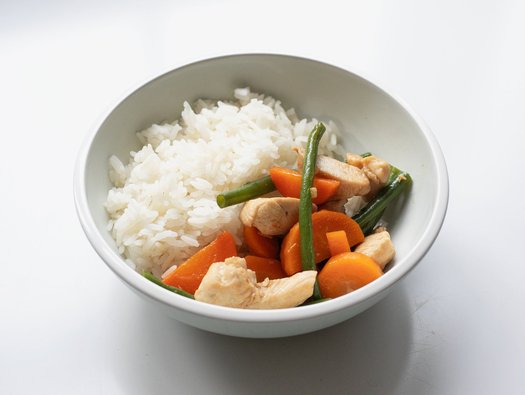Oyster sauce stir fry

A low-protein dish that’s also great for those following a low potassium and / or phosphate diet.

A low-protein dish that’s also great for those following a low potassium and / or phosphate diet.
200g chicken breast or pork shoulder slices, diced
160g trimmed green beans
160g sliced carrots
10g caster sugar
300g white rice
1 tablespoon low-salt soy sauce
1 tablespoon oyster sauce
1 teaspoon vegetable oil
1 garlic clove, finely chopped
Cook the rice as per the instructions on the packet.
Parboil the carrots and green beans for 5-10 minutes then drain.
Pour the oil into a frying pan and heat on a medium heat. Add the garlic and cook until slightly golden in colour.
Add the meat and sugar to the pan and cook until the meat is golden brown on both sides.
Once the meat is cooked, pour in the soy sauce and oyster sauce and stir-fry for 3-5 minutes.
Add the parboiled vegetables into the pan and stir-fry until the meat and vegetables are all coated in sauce. Serve with the cooked rice.
The rice is the main source of carbohydrate in this recipe, and the value has been provided for those who have been trained in insulin adjustment.
This recipe is low in potassium and can be enjoyed as part of a low potassium diet, when following the quantities for all the ingredients and the serving sizes.
This recipe is also low in phosphate, however it still contains some phosphate, provided by the chicken and rice, therefore, if you are prescribed a phosphate binder you should take as directed.
This recipe is high in protein, which makes it suitable for those advised to eat more protein. If you have been advised to reduce your protein, then replace the chicken with 350g of tofu.
Use a gluten-free soy sauce such as Tamari and gluten-free oyster sauce.
Replace the chicken with tofu.
There is no added salt in this dish, however it is moderate in salt, which is predominately coming from the reduced-salt soy sauce and the oyster sauce. Therefore, measure the quantities carefully and, if you find the flavour too strong, consider reducing the amount used to lower the salt content. To increase the fibre of this dish consider using a wholegrain brown rice in place of white rice.
This dish is best eaten fresh.
Why delicious, healthy food you can enjoy with family and friends is so important.
You can enjoy a wide variety of delicious and healthy food when you are living with kidney disease. All Kidney Kitchen recipes are analysed and approved by kidney dietitians. Search through our kidney-friendly recipes or filter them by category below.
Whip up this tasty, Asian inspired stir fry with tender beef. Perfect for a busy weeknight dinner or to make ahead and freeze.
By giving us your email address, you're giving us permission to send you the latest news from Kidney Care UK. Further information about how we protect and use your personal data is available in our Privacy policy. If you would like to change the way we communicate with you at any time please email [email protected]. You can unsubscribe at any time by using the link at the bottom of every email we send.